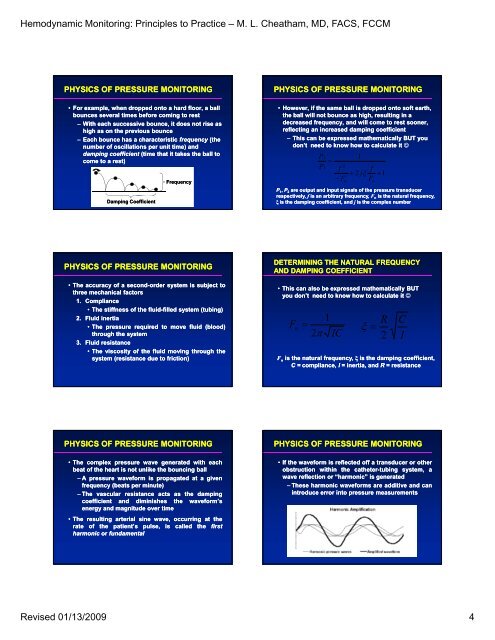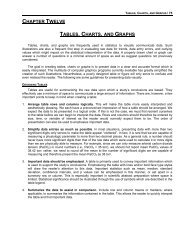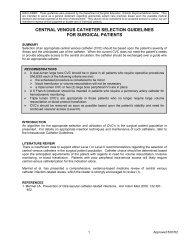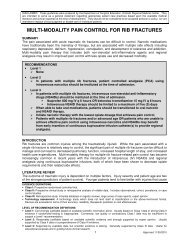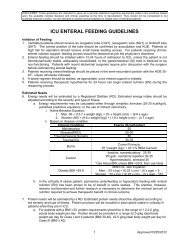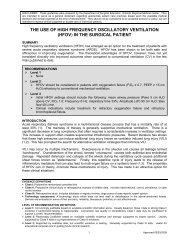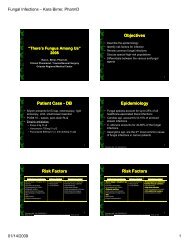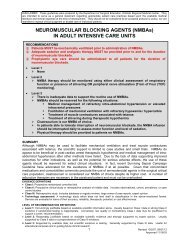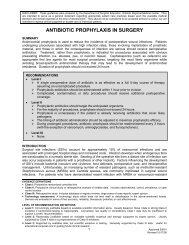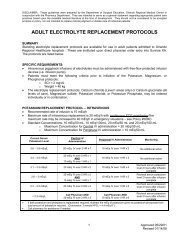Hemodynamic Monitoring: Principles to Practice â M. L. Cheatham ...
Hemodynamic Monitoring: Principles to Practice â M. L. Cheatham ...
Hemodynamic Monitoring: Principles to Practice â M. L. Cheatham ...
Create successful ePaper yourself
Turn your PDF publications into a flip-book with our unique Google optimized e-Paper software.
<strong>Hemodynamic</strong> <strong>Moni<strong>to</strong>ring</strong>: <strong>Principles</strong> <strong>to</strong> <strong>Practice</strong> – M. L. <strong>Cheatham</strong>, MD, FACS, FCCMPHYSICS OF PRESSURE MONITORING• For example, when dropped on<strong>to</strong> a hard floor, a ballbounces several times before coming <strong>to</strong> rest– With each successive bounce, it does not rise ashigh as on the previous bounce– Each bounce has a characteristic frequency (thenumber of oscillations per unit time) anddamping coefficient (time that it takes the ball <strong>to</strong>come <strong>to</strong> a rest)Damping CoefficientFrequencyPHYSICS OF PRESSURE MONITORING• However, if the same ball is dropped on<strong>to</strong> soft earth,the ball will not bounce as high, resulting in adecreased frequency, and will come <strong>to</strong> rest sooner,reflecting an increased damping coefficient– This can be expressed mathematically BUT youdon’t need <strong>to</strong> know how <strong>to</strong> calculate it ☺P2=P12f2− Fn1f+ 2 jξF n+ 1P 1 , P 2 are output and input signals of the pressure transducerrespectively, f is an arbitrary frequency, F n is the natural frequency,ξ is the damping coefficient, and j is the complex numberPHYSICS OF PRESSURE MONITORING• The accuracy of a second-orderorder system is subject <strong>to</strong>three mechanical fac<strong>to</strong>rs1. Compliance• The stiffness of the fluid-filledfilled system (tubing)2. Fluid inertia• The pressure required <strong>to</strong> move fluid (blood)through the system3. Fluid resistance• The viscosity of the fluid moving through thesystem (resistance due <strong>to</strong> friction)DETERMINING THE NATURAL FREQUENCYAND DAMPING COEFFICIENT• This can also be expressed mathematically BUTyou don’t need <strong>to</strong> know how <strong>to</strong> calculate it ☺F n1=RCξ =2πIC 2 IF n is the natural frequency, ξ is the damping coefficient,C = compliance, I = inertia, and R = resistancePHYSICS OF PRESSURE MONITORING• The complex pressure wave generated with eachbeat of the heart is not unlike the bouncing ball– A pressure waveform is propagated at a givenfrequency (beats per minute)– The vascular resistance acts as the dampingcoefficient anddiminishesthewaveform’senergy and magnitude over time• The resulting arterial sine wave, occurring at therateof thepatient’spulse, iscalledthefirstharmonic or fundamentalPHYSICS OF PRESSURE MONITORING• If the waveform is reflected off atransduceror otherobstruction within the catheter-tubingtubing system, awave reflection or “harmonic” is generated– These harmonic waveforms are additive and canintroduce error in<strong>to</strong> pressure measurementsRevised 01/13/20094


